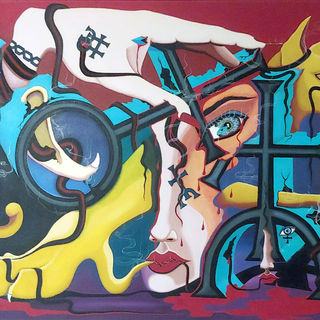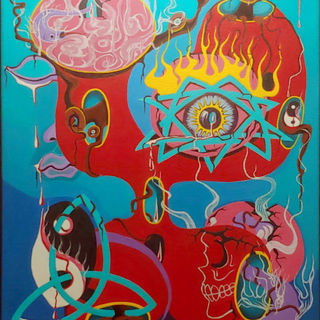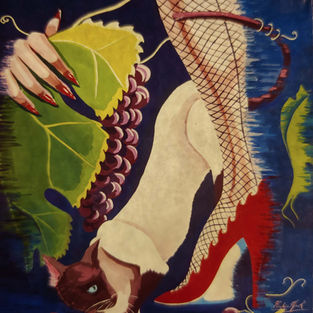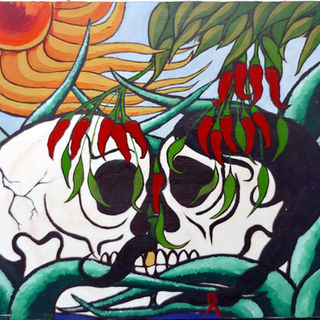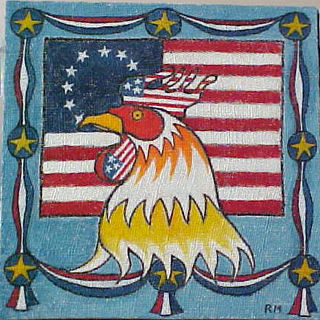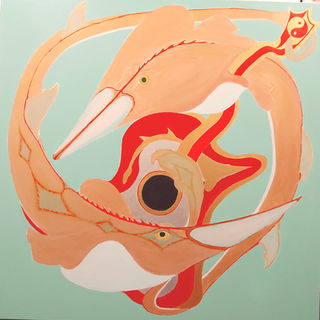RICHIE MACK'S VIRTUAL GALLERY
Explore unique and mesmerizing paintings by "Riche Mack"
Greetings, I'm Thane Haynes, son of "Richie Mack". I created this website to showcase my father's artwork. Hope you have as much fun browsing this site as much as I had making it.
To my current knowledge, dad didn't title many of these paintings, so I've created my own titles, in order to help viewers identify them. I titled them based on their ostensible meanings or what dad had told me about them. All titles which are in quotations are those which dad had made -- the same goes for the descriptions. The vast majority of his paintings are oil paint on canvas. Some of the canvases he stretched himself [I'm not sure which ones they are, aside from the burlaps]. Most of the canvases are quite sizable, since he liked to "paint big". Most of his paintings are conceptual and abstract. He sometimes referred to his paintings as "modern art," being called that, I think that they could potentially redefine or diversify modern art. Unfortunately, many of his paintings aren't dated. From this point on, I'll refer to dad as "Rich" or "Richie," as a means to make the site professional.
Restaurant Collection
This is a collection of conceptual, abstract oil-paintings that Richie painted in 1987, when he lived in New York City. To sell these paintings (and to promote his artwork overall), Rich framed and hung them in an NYC restaurant, not too long after he completed them. Like most of his artwork, these pieces are unique, uncanny, and painted with oil-paint on canvas, but these somewhat reflect the decade in which they were painted, which gives them a peculiar charm. Also, like most of his paintings, they are difficult to visually interpret. The titles are interesting, and add to the mystique of the paintings. And unlike most of the images in this gallery, these are images of backlit projection slides, which were developed back in 87. The original paintings were either sold or given away long ago, and their whereabouts are mostly unknown.
*THESE SHOTS MAY BE REPLACED BY HIGHER QUALITY SHOTS EVENTUALLY*
Indian collection
A series of Native North American themed paintings.
Comic Collection
A series of cartoonish, comical paintings.
Mexican Collection
A series of Mexican-themed paintings which are also quite comical, and a bit folky.
The Burlap Collection
Rich not only painted these canvases; he made them from scratch. They consist of burlap stretched over plywood panels.
Unfinished Paintings
Incomplete, but still admirable.
Screen Prints
These are screen prints, and blocked acetate sheets for making printing screens. Rich made these from the 80s to early 90s. Printing screens were used to print images onto fabric. Likewise, Rich used the screens to print his artwork onto clothing (mostly T-shirts). Of all Rich's artwork, these prints most strongly reflect the era in which they were created.
Back then, printing screens were emulsified by covering a framed screen with "photo emulsion," a type of gel which hardens under white light. The artist would draw his/her design on an "acetate sheet" (transparent film), with a "opaque pen" (a type of red marker). The acetate sheet was aligned and placed between the emulsified screen and a "light box". After some time, the light from the light box would harden the photo emulsion, except in the areas which were blocked by the opaque pen on the acetate sheet. The screen is then rinsed with water, to wash out the unhardened emulsion, leaving negative-space on the screen, shaped just like the artist's design. Printing ink is pressed through this negative space and onto the desired cloth, leaving the design printed on the cloth. After initial drying, the ink is fully cured by putting the cloth in the dryer.
There was simpler method of emulsifying printing screens, which was to brush "opaque ink," onto the desired areas of the screen, and let it dry. Screens which were emulsified this way, generally did not yield as-fine prints as the screens that were emulsified with the aforementioned method. Rich used both methods to emulsify screens.
The Murals
In New York City, around 1985, Rich painted two murals for one of his friends.
They were painted directly on concrete, on the exterior of his friends house. To my knowledge, this is the only time Rich had painted pure landscapes, but even so, they have unique style and nuance, which would probably be considered too rash for the typical landscape artist. Rich didn't name them, as far as I know. If I were to name them, I'd call the first one "Coast" and the second one "Field".






